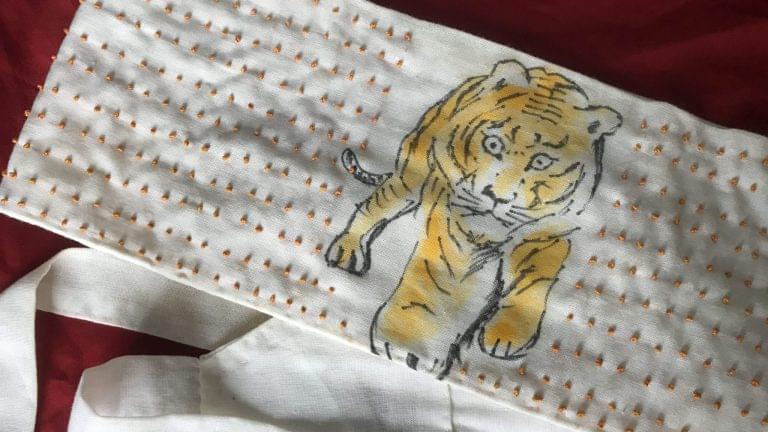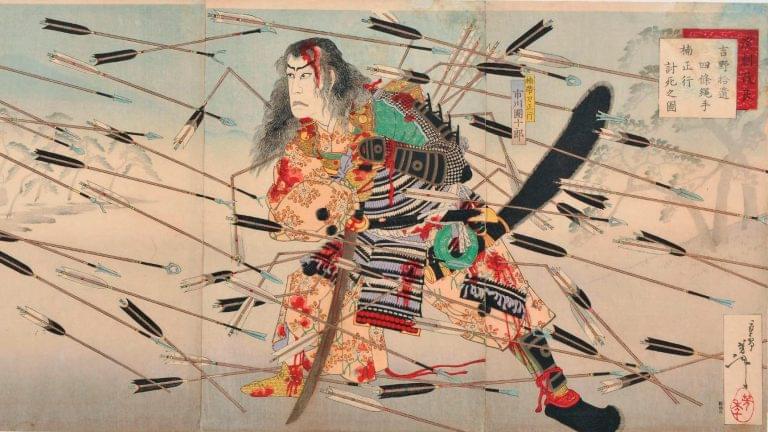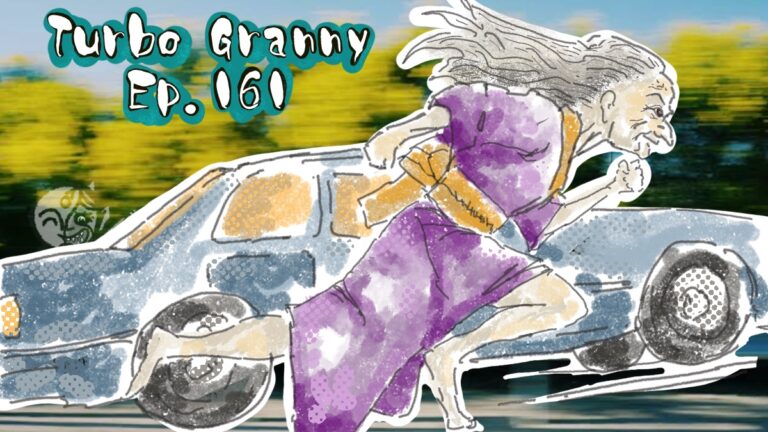Bloom and Gloom or Cherry Blossom Folk Beliefs or Sakura: The Wonderful and the Worrisome
Hello there, I’m Thersa Matsuura and you’re listening to Uncanny Japan.
What do you know about sakura or cherry blossoms? Let me guess, something like, every year in Japan when spring rears its balmy, bird-chirping, flower-budding head, the trees fill with delicate powder-pink blooms. People come out in droves to stroll, picnic, or party underneath the pretty petal showers, every one of them celebrating this symbol of renewal and hope while simultaneously pondering the fragility and impermanence of life and how they, too, will fall and be retaken by the earth.
Or something like that. You’re not wrong, but there’s more. The stuff people aren’t talking about.
So go grab a blanket, make yourself an obento filled with onigiri, salted edamame, crispy chicken kara-age, some sliced tamagoyaki-rolled egg and maybe some juicy strawberries . I’ll bring the drinks and Meiji chocolate and let’s meet under the blooming cherry trees to learn everything you ever wanted to know about…cherry trees.
Hint: There’s a dark side, too.
Intro
Hey hey, Happy Spring!
Sakura Hanami Meanings
I’m pretty sure you already know, but just to be sure, sakura means cherry blossoms and hanami is “flower viewing”, but these days almost exclusively means “cherry blossom viewing”. Hanami or ohanami can be a leisurely meandering under a long row of flowering trees on a river bank; or a picnic with your best buddy under a single tree in a park; or even a nighttime party with all your rowdy friends, a generator hooked up to lights and a portable karaoke machine, and coolers full of beer. I’ve seen all three.
Sakura Basics: Types, Oldest, Newest (Space Tree!)
Some basics: While in Japan, there are anywhere between 200 and 300 different kinds of cherry trees, the majority — somewhere around 70 to 80% — are called Somei Yoshino. Just so you know.
The oldest cherry tree here is in Yamanashi Prefecture, Hokuto City. It’s called Jindai Zakura and estimated to be around 2,000 years old. In 2009, 118 seeds from the tree were taken into space by NASA where they spent eight months circling the earth in the Space Station. Out of all those seeds, only two sprouted. One of those was named Uchu Zakura (Space Sakura) and now resides at Jissoji Temple. It’s special in that, cherry blossoms usually have five petals per flower, but the Space Sakura has six. Which very curiously aligns with the six posthumous worlds in Buddhism/the Rokudo. Hell, hungry ghosts, beasts, asuras, humans, and gods. Coincidence? I think not.
Except for the occasional enduring sakura — like Jindai Zakura — they aren’t super long-lived. They’re delicate and have shallow roots and susceptible to various pests, diseases, and environmental stress. An example, just last week I was woken up at seven am to the sound of chainsaws outside my window. To my horror a bunch of men in helmets were out there chopping off all the limbs of the trees in the park across the street. Afterward, I went weeping to my neighbor lady and her guess was caterpillars. She said even spraying doesn’t always help and once they take hold, the trees are doomed, so you have to just prune them drastically to nip them in the bud. Later, I went over and examined them and saw all the cut branches were sealed with wax. That makes sense because doing research for the episode I learned an old saying.
Don’t Cut Cherry Trees
Sakura kiru baka, Umekiranu baka / 桜切る馬鹿、梅切らぬ馬鹿. He who cuts a sakura tree is a fool. He who doesn’t cut a plum tree is a fool. Meaning, you’re not supposed to prune or trim cherry trees because cutting actually exposes them to diseases and bugs (hence the wax caps they put on the trees across the street). On the other hand, you do want to trim plum trees. They do better after being trimmed.
History
So the first hanami is believed to have started with Emperor Saga (who reigned from 809 to 823) when he introduced something called a Hana no en/花宴, which was basically the same thing: Parties under the flowering trees, minus generators and a karaoke machine. Whether they were cherry or plum though, I’ve read both sides. It sounds, though, like this tradition came from China during the Heian Period (794~1185) and it was enjoyed while celebrating Ume or plum blossoms. But during this time, Japan began to distance itself from China and started developing its own unique culture. One thing they did was nix the plum blossom viewing and switch to cherry trees.
Aside from the fact that Japan was finding its cultural identity there are some more reasons to revere the sakura over the ume. Not that plum blossoms aren’t loved and picnicked under here. They are. But by far people get more excited about sakura. So I did some asking and some reading and there are a couple reasons.
Why Cherry Trees over Plum Trees?
One is simply sakura bloom after plum trees which means it’s warmer, spring is more in the air so to speak. I very vividly recall going out to hanami with friends and family as a student here and freezing. Once with my kendo club, saying out loud, it’s just too cold to enjoy this are you all insane. Or something like that. Then you have nighttime cherry blossom viewing, called Yozakura, with the trees all under-lit by big lights or hung with paper chochin lanterns, which is really nice but colder still. Now imagine a whole month earlier to see plum blossoms. February is like the coldest month. So it’s easier and more enjoyable to partake in April. However, I’ll add that climate change is, well, changing things, and the past, I don’t know, ten years it’s been gorgeous weather during the cherry blossom blooming period.
Another reason for cherry over plum, is that the trees are perfectly bare through the winter, no leaves or anything. Spring comes and you see the first buds start to appear, there’s a couple days of rain and the the flowers bloom almost all at once. Not just one tree coming into full bloom, either, but rows of trees, entire parks. It can be quite breathtaking. And that all happens before they grow leaves. Leaves are yucky (as I’ve been educated by some). And — this isn’t me talking, I was often told — that it’s not even worth going out and sitting under a tree if the leaves have come out. There’s even a word for it, too. Hazakura. Leaf Sakura.
Now, I don’t think that’s true, but the green leaves do change the view. Now instead of great clouds of pastel pink flowers against a vivid blue sky, you have leaves in there, another color.
A final reason is the sheer numbers of blossoms compared to plum trees which make one blossom per bud. A cherry blossom’s bud, though, will produce anywhere from three to five flowers on little stems. Some professor wrote that. I never even noticed. So Sakura trees have tens of thousands, no hundreds of thousands of petals per tree to shower over you, and that’s a lot. We’ve all heard the life is fleeting schtick, but this Tanaka Osamu fellow says that even more than that, since the trees are ornamental and don’t produce fruit even more so we must appreciate them for what they are in that short moment with no expectation of any additional return, like an actual cherry or a plum.
Sakura News and Special Vocabulary
There’s something else I’ve always gotten a kick out of, and that’s how the weather news every spring season is all excited about the Sakura Zensen/Cherry Blossom Front, giving daily updates on how the blooming is going as it moves up Japan. There is even a special vocabulary you learn real quick when watching these daily updates.
Kaika/開花 means blooming. Sanbusaki/三分咲き means three-quarters are blooming the rest are still buds. Gobusaki/5部咲き half are in bloom. Then when you hear hachibusaki/8部咲き, 80% or more are blooming and that also pretty much equals mankai/満開 full blooms. So you need to hurry up and get out there. Because tomorrow you’re going to hear chirihajime/散り始め. That means they’re starting to scatter those pretty petals. And after that is hazakura/葉桜, Yuck, leaves. They are no longer lovely.
Interesting Legend
Here’s a funny thing I read. In Japan you’ll notice that sakura are very often found along riverbanks and do you want to know why? Well, it’s a theory, but some believe the Yoshimune had cherry trees planted all up and down the Sumida River which flooded quite often back then. What he predicted would happen was that crowds of people would flock to see the blossoms, everyone walking along the riverside thus pounding down the earth there, making it less likely to be washed away with the next hard rainfall. The idea spread all over the country. Huge, if true.
But Why Not in People’s Yards?
Because sakura are so beloved and ohanami is so much fun, if you’re like me you’ll wonder why — when you visit Japan — there aren’t any cherry trees in people’s yards. The baffled me for years. Parks, riverbanks, university campus, but I never saw any near a private residences. So I asked my mother-in-law and she just said no one would ever have a sakura in their yard. She wasn’t real specific, but she said they’re difficult to keep because they’re sweet and loved by caterpillars. Which corroborates my neighbor’s story. But she also said they were unlucky. That stuck with me.
Now for the darker side of the sakura, the side you didn’t know you didn’t know. Because I didn’t know. Well, maybe you knew. But I didn’t know that. So…
Bad Luck
As it turns out it’s true they were thought to be inauspicious, and I found out more from my old Japanese superstitions and folk beliefs book. After the boom in the Heian Era when every spring the aristocracy and then later the common folk enjoyed their ethereal beauty while pondering the transcience of human existence they sort of took a dark turn. Which explains why you hardly ever find someone with yard full of sakura.
I read that exactly because the are associated with fragility, sadness, and even fear that they are not considered especially lucky trees. Describing the way the petals fall we say chiru, which means to scatter, be dispersed, or run. Also, not particularly fortuitous words.
There were times when the trees were planted as a way to comfort the spirits of the dead. A way to remember and console the souls of the departed. So now there’s an added ghostly vibe and some people do find them off-putting.
There’s a goddess named Konohana Sakuya-hime who legend has it gave birth to the cherry blossom. Yet she didn’t live very long for a goddess and that carried over to the cherry tree not having a particularly long life either. Just like its mom.
There are dozens of variations from different prefectures saying somelike the above or things like: don’t plant a cherry tree in your garden because your household won’t prosper, you’ll be ruined and your luck will scatter. I get the imagery of that last one. Some superstitions went that you shouldn’t plant a weeping cherry tree because they should only grow on temple grounds. All of this might have to do with their delicateness and the fact that they grow quickly, but also decay quickly.
Then there was the association with samurai. Here’s a saying about that: Hana wa sakuragi hito wa bushi/ 花は桜木、人は武士. The cherry blossom is the most beautiful flower, and like the cherry tree, which blooms and falls quickly, a samurai who is graceful and beautiful at the time of death is the best.
I also read that on Iki Island it’s taboo to burn cherry tree wood. In some areas in Japan if you use sakura wood to steam mochi you will become poor and if you use the wood to cook some ozoni soup you’re entire family will perish. Harsh.
But there’s a reason. Hear me out. It was very valued wood, very expensive, so any family that was careless and dare I say dumb enough to use it to stoke their kitchen fire with it, surely would loose all their fortune.
Now this one might have changed over the years because while, no, I don’t see cherry trees in anyone’s yards, they do sell cherry wood chips at the local hardware store for smoking foods and campfires and no one’s going on about disappearing fortunes there.
Folk Medicine and Superstitions
Would you like to hear some ancient folk medicine? Don’t do this by any means, but some believed ingesting the bark of the tree helped relieve nausea, diarrhea, stomach disorders, rashes, pain, and a remedy for fish poison. And by fish poison, it’s hard to know for sure what was meant whether it’s food poisoning from eating old fish (likely) or getting sick from licking the ovaries of a fugu blow fish (I don’t know, probably less likely…but a wonderful image. Hey, Saburo just licked a blowfish quick go gnaw on the cherry tree.)
There was also the belief that the branches and leaves had the power to ensure a safe childbirth. And amulets called Sakura Yoji were given to expectant mothers. On the other hand, if you’re pregnant and using that sickle to hack away at something, never hang it on a cherry tree or you’ll have a difficult labor.
It’s no surprise that cherry trees were used for farming. And back when there were more varieties, different area all over Japan would have the Seed Sowing Sakura, you started planting when it bloomed and the Threshing Sakura, time to thresh those seeds, and the Rice Planting Sakura. You know what happens when that one blooms.
Three Sakura Legends from Kyoto: 1. Decapitation Sakura
Now let me end with a couple cool Sakura stories from Kyoto.
Every year when the Somei Yoshino blossoms start to fall another variety of cherry blossom called the Fugenzo Sakura blooms on the grounds of the Senbon Shakado Temple in Kyoto’s Kita Ward. Fugen is a Buddhist Boddisatva and zo means elephant. The reason these trees are called Fugenzo is because the leaves resemble the ears of the elephant Fugen rode.
But there’s something else, instead of shedding petals like most of the others, these trees drop the entire flower. What does that remind you of? Why, yes, a prisoner getting his head chopped off. The tree became associated with the executions that took place around the temple. So much so that rumor has some prisoners went to their death (by decapitation) holding a branch of the Fugenzo cherry tree clutched in their hands.
2. Crying Sakura
A second legendary tree is the mysterious blossom called the Shigure Sakura or Rain Shower Sakura or Drizzling Sakura. This can be found at the Tsukinowa Temple at the foothills of Atago Mountain in Ukyo Ward, Kyoto. This temple is incredible in and of itself, found in 781 it’s associated with the Shugendo Sect of Buddhist and such greats as Kuuya, Hounen and Shinran. Speaking of Shinran it’s believed he’s the one who planted this particular Shigure Sakura which blooms from late April to May and that the leaves of the tree shed tears. I read about a man who visited there on a sunny day, but still the leaves held these perfect droplets that looked like tears. They’re said to represent Shinran tears at having been exiled or the tears of his followers who would miss him or again his tears at having to part ways with the great Honen. Someone cried and the tree picked up on it and continues the tradition every spring, it seems.
3. One-Thousand Eyes Sakura
And finally, in Nishikyo-ku, in Kyoto there is a tree call the Sengan zakura千眼桜 at the Oharano Shrine. It’s a weeping cherry tree and the blossoms’ shape resembles lanterns, but from a distance it looks as though they have many eyes. And so it has been dubbed The Thousand Eyed Cherry Blossom. It has an especially short blooming period of only two to three days, so it’s said that if you are able to catch it in full bloom you will be granted a thousand wishes! Not one, not two. A thousand!
And on that note, I wish all a very lovely day filled with a thousand wishes and zero decapitations.
I’ll talk to you in two weeks. Bye Bye







Apparently there is a cherry blossom tree in Kanazawa with blue flowers. I wasn’t able to tell if the article was real or some sort of joke or hoax. Whatever the case, the picture looked like a white-flowered tree that had developed a faint blue tint.
I’m going to have to look that up. It sounds kinda real, doesn’t it. Literally, yesterday on my walk I passed under a very white cherry tree that had such an “off” color to it I snapped a phone photo. I’m going to have to look at it and see if it doesn’t have a blue tinge. I don’t think I can post it here…hang on…